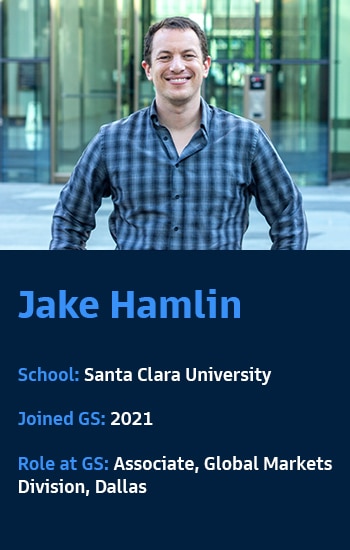Living on the Spectrum – and Embracing the Upsides
Jake Hamlin, an associate in Goldman Sachs’ Global Markets Division in Dallas, talks about how being on the spectrum became a competitive advantage for both him and the firm.
 People ask me what it’s like to be autistic. It’s a hard question to answer, but one thing the pandemic has done is give me a metaphor I can give to you. Think about the last time you were on Zoom. You could see the person you were talking to, you could hear them and everything was happening in real time, but there was a clear difference between that conversation and your experience with that person live. That’s how I experience much of the world; I can see and hear everything around me, but there is this invisible barrier that I just can’t penetrate.
People ask me what it’s like to be autistic. It’s a hard question to answer, but one thing the pandemic has done is give me a metaphor I can give to you. Think about the last time you were on Zoom. You could see the person you were talking to, you could hear them and everything was happening in real time, but there was a clear difference between that conversation and your experience with that person live. That’s how I experience much of the world; I can see and hear everything around me, but there is this invisible barrier that I just can’t penetrate.
Autism comes with upsides, as well as downsides. We struggle to varying degrees with social awkwardness, executive functioning, and sensitivities to lights, sounds and tastes, but we’re also capable of understanding and interacting with the world in unique ways. Among other common traits, we recognize patterns neurotypical people can’t see, we’re capable of levels of focus that allow us to generate unique insights, and we absorb and retain facts and information in a way that makes us invaluable resources. We’re entrepreneurial and creative, and we find ways to make life work in spite of our challenges.
One of those challenges is employment – the unemployment rate for autistic adults with a college degree is 85 percent. I’ve personally struggled for years to find the right career path, which ultimately led me to mistakenly believe that companies just weren’t interested in hiring people like me. That is until I joined Goldman Sachs in 2021 through its Neurodiversity Hiring Initiative. The firm recognized an opportunity and partnered with Specialisterne, a nonprofit that specializes in recruiting neurodiverse talent, to launch a program in 2019 that could help identify candidates and provide value to both the candidate and the firm throughout the recruiting process. The program was initially focused on Engineering, but has since expanded to Operations with plans to expand to other areas across the firm in the coming years.
Throughout the program, candidates participate in a three-week assessment process, followed by an eight-week internship with a manager who has been trained to work with a neurodiverse employee. As a participant, I was encouraged to actively fight my instinct to camouflage and instead fully embrace, in my professional life, this part of my identity that I’d spent more than 15 years trying to deny. I’d always feared that if I didn’t hide this part of my story I’d never be welcomed, that there would always be distance, but I’ve found that the opposite to be true. The more honest I am, the closer I feel to the people around me like my colleagues and teammates.
The goal of the Neurodiversity Hiring Initiative is to identify talented individuals who may not have come to the firm through the traditional recruiting process. Everyone involved is proud to say that all seven interns who completed the program in year one, and all nine of us who completed the program the second year, have gone on to accept full-time roles with the firm. It goes to show the caliber of achievement possible for someone on the spectrum, and makes obvious the value that people like me can bring to the firm if given the chance with the appropriate hiring process.
Though I still worry about the risks of being open about my diagnosis, and I understand why people might choose to hide, I hope to say to anyone who is struggling that the benefits of disclosure far outweigh the benefits of camouflage. In addition to the Neurodiversity Hiring Initiative, Goldman Sachs has many resources available, including the wonderful Disability Network. But most importantly, the firm has wonderful people who will accept, welcome and support you.
Applications for the 2022 Neurodiversity Hiring Initiative are now open:

